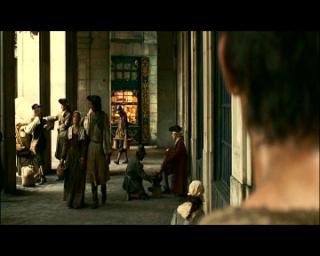/ Home / Attractions / Plaça ReialPrint version
Plaça Reial
.JPG.medium.jpg)  
|
.jpg.medium.jpg)
|
Historic information
The development of the Plaça Reial is the result of the seizure of ecclesiastical assets in 1835, when the convents and churches were confiscated by the State. The Capuchin convent, which had stood on the site since 1718, was demolished to make way for a number of projects including a major theatre and glassed-in galleries which are thought to have been the first of their kind in Europe, before those designed in Milan. Finally, in 1848 the decision was taken to build a square designed by Francesc Daniel Molina. The Plaça Reial is one of Barcelona’s few enclosed squares, which successfully incorporates passageways on every side. The buildings around it comprise a uniform ensemble with a porticoed ground floor, decorated with Hellenistic terracotta motifs, busts of navigators and explorers of the Americas and shields underpinned by Indian infants. The Three Graces cast-iron fountain and the streetlamps, designed by the young Gaudí, with their arms sprouting at different heights like the branches of a tree, were added at the end of the 19th century. Barcelona City Council commissioned Gaudí to draw up a project for gas lights which would be placed around the city. The two streetlamps in the Plaça Reial and the three in the Pla de Palau are the only ones created as a result of this ambitious commission. They have a dark-marble base, and the central part of the column is crowned by two snakes coiled around a stick and a winged helmet symbolising Mercury, the protector and god of trade, one of the city’s most characteristic activities. The column also bears the coat of arms of Barcelona. The square was remodelled by the architects Frederic de Correa and Alfons Milà between 1982 and 1984, and two particularly important aspects of the project were the removal of traffic from the square and the planting of palm trees.
In order to know the zone better
The Plaça Reial is one of the city’s special sites. The aesthetics of its urban design and architecture, the fact that it is a meeting place for a broad cross-section of people, the ambiance created by its many bars, terraces and nightspots and the history experienced within its four walls are just some of the elements that make it unique. As if time had stood still in this square, a shop dating from the early 19th century still survives here. On the Carrer del Vidre, which goes from the Plaça Reial to the Carrer Ferran, you’ll find the Herboristería del Rey, a shop that can be seen in the film "Perfume". In the middle of the shop there is a fountain where leeches used for blood-letting were once kept. The marble pillar in the centre at the back of the shop is crowned by a bust of the 18th-century Swedish physician and botanist Linne.La Rambla is located just a few metres from the square. It is the city’s landmark boulevard, crowded with people both day and night, with its characteristic flower and bird stalls, as well as newsstands, restaurants and shops. All kinds of artists and performers (cartoonists, painters, mime artists, jugglers) add extra vibrancy to the “world’s most joyous street”, in the words of the poet Federico Garcia Lorca. Some of the most outstanding buildings that line the boulevard are the opera house, the Gran Teatre del Liceu, and the Market of Sant Josep, better known as the “Boqueria”.
|
Scene description
Perfume: The Story of a Murderer
  
Plaça Reial: Jean-Baptiste Grenouille (Ben Whishaw) experiences new and unknown olfactory experiences on his first trip to Paris. While Grimal (Sam Douglas) is delivering one of his orders, Grenouille detects a new, intense scent which he feels compelled to follow. He crosses a porticoed square and sees a perfumer’s shop in front of him. He stops in front of the shop window and admires a group of women inside who are trying a bottle of perfume (Amour et Psyche) which is being offered by Monsieur Péllisier (Jaume Montané), the most celebrated perfumer in Paris. This is the first time Grenouille has come across a shop of this kind and he realises that he could make a career out of creating perfumes.
|
Did you know that...
The scene was shot in the Plaça Reial. Although it wasn’t necessary to make any changes to the porticoed structure around the square, the scene showing Grenouille crossing from the arches in the square to the Carrer del Vidre proved costly as the production company had to pay the restaurants and bars to close their terraces that appeared in the shot. The scene required 150 extras. The perfumery discovered by the main character really exists. It is a herbalist’s called the Herboristería del Rey, one of Barcelona’s oldest shops, founded in 1823.
|
The Barcelona of Perfume
/
Plaça Reial

